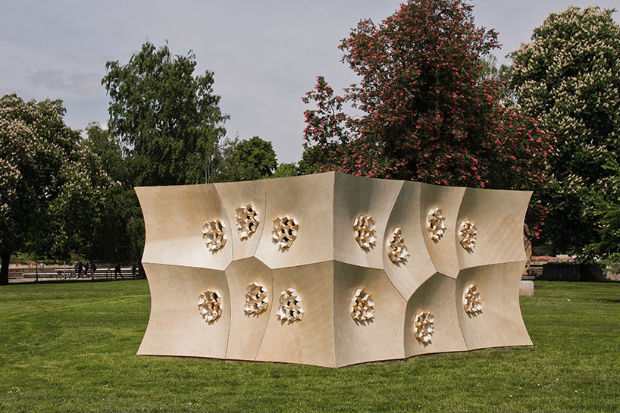Fulton Center, an impressive glass and steel building dominated by a huge transparent dome Designed by Grimshaw and Arup…

‘It is a question of surrendering to the wood, then following where it leads by connecting operations to a materiality, instead of imposing a form upon a matter‘ – gilles deleuze and félix guattari
Professor at the Institute for Computational Design and Architect Achim Menges in collaboration with his colleagues Steffen Reichert and Oliver David Krieg have developed two biomimetic meteorosensitive pavilions: ‘hygroskin’ (on permanent display at the frac centre) and ‘hygroscope’ (on display at the centre pompidou).
Hygroscopicity refers to an objects ability to absorb moisture from its environment when dry and shed moisture to its environment when wet. utilizing the intrinsic physical characteristics of wood and its one-directional nature the project creates a hygroscopic mechanism that requires no energy or metabolic process to run, as it is entirely animated by the naturally changing climate. Responding to humidity, paper thin triangular wooden flaps absorb air moisture and expand. as they are essentially the thickness of a one-directional grain, the sheets are forced to unwrap themselves, effectively meeting at the center point of an aperture and closing it – when dry, the wood constricts to reveal merely a web of thin structural members and thousands of openings. The spruce cone has proven an invaluable source of research, as its characteristics fulfill exactly this purpose without the need for external or internal energy sources. In this way, architecture can explore the benefits of a living structure that responds directly to changes in the environment due to its mechanical properties that require no energy whatsoever.
Hygroskin is a pavilion located at the Frac Centre Orleans. made of a modular steel frame in the form of a voronoi-esque diagram. Spanning each frame, concave plywood sheets are bent to their natural elastic capacities, containing within them a smaller diagram of responsive apertures. With the help of laser scanners and a 7-axis industrial robot the team was able to produce the timber skin structure from precisely molded thin sheets whose geometry provide it with the necessary rigidity while remaining extremely lightweight.
Hygroscope pushes the concepts explored with hygroskin as applied to a much more complex environmental sensitivity. The breathing model floats in a glass case whose micro-environment is composed of two data sets: one, an exact mirror of the current meteorological conditions in paris; the second being a proportional parallel to the amount of humidity emanated from the number of visitors. The maquet becomes a visual gauge interpreting the subtle changes in humidity as it exists outside the center pompidou with relation to the amount of pedestrian traffic around it. Using computational algorithms to derive a form which is a direct response to theoretical climatically unstable zones, each aperture is essentially programmed to respond to different levels of humidity based on the slight change of one of the following five factors:
- the fibre directionality
- the layout of the natural and synthetic composite
- the length-width-thickness ratio
- geometry of the element
- the humidity control during the production process
More than a direct response to a climatic condition, ‘hygroscope’ explores the complex application through localized responses to unique meteorological zones- a synthesis of concrete physics, computational design and leading edge manufacturing processes.
Credits:
Photos: © ICD University of Stuttgart
Prof. Achim Menges Architect Institute for Computational Design, University of Stuttgart, Germany Hygroskin Pavilion and Hygroscope Installation, France
Completed: 2013
Materials: Wood, Steel
Applications: Envelope,Structure









